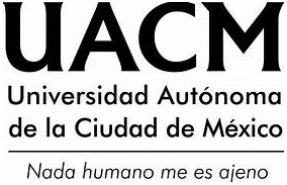NEOLIBERALISM AND SOCIAL RIGHTS AN ECONOMICAL AND POLITICAL VISION
DOI:
https://doi.org/10.29092/uacm.v3i5.347Keywords:
Social rights, human rights, economic rights, Breton Wood´s, integral democracyAbstract
This study tries to explain the fundamental causes of post war and the world, to revise them and compare them against it´s actions from 1975 to the year 2000. Specifically the contrasts between the defense of social rights, to be understood as the combination of civil rights and economic rights: Besides all of the above, we present an initial draft of what might be the articulating angles of a proposal that allows us to overcome neoliberalism.
Downloads
References
BANCO MUNDIAL (2003), Informe sobre el desarrollo mundial 2003. Desarrollo sostenible en un mundo dinámico. Bogotá: Banco Mundial / Mundi Prensa Libros / Alfaomega.
CASAR, J. y J. ROS (2004), “¿Por qué no crecemos?” en Nexos, núm. 322, México, octubre.
DELGADO, Orlando (1994), “Las tareas de las empresas públicas en la dé- cada de los noventa: apuntes sobre la gestión y los trabajadores” en Revista de Administración Pública, núm. 86. México: Instituto Nacional de Administración Pública.
DUBY,G.yR.MANDROU (1981),Historiadelacivilizaciónfrancesa.México: Fondo de Cultura Económica.
FAST, Howard (1999), El ciudadano Tom Paine. Barcelona: Seix-Barral.
FRIEDMAN, M. y A. SCHWARTZ (1974), Monetary trends in the United States and the United Kingdom . Chicago: The University of Chicago Press.
HARROD , Roy (1958), La vida de John Maynard Keynes. México: Fondo de Cultura Económica.
HAVEL, Vaclav (2004), “Strangling democracy” enNew York Times, 23 de mayo. HOBSBAWM, Eric (1998), Historia del siglo XX. Buenos Aires: Crítica.
_____ (1974), Las revoluciones burguesas, t. I. Madrid: Guadarrama.
KEYNES, John M. (1965), Teoría general de la ocupación, el interés y el dinero. México: Fondo de Cultura Económica.
LETWIN, Oliver (1988), Privatising the World. A study of internacional privatazing in theory and practice. London: Cassel Educational Ltd.
MADDISON, Angus (2003), The World Economy: historical statistics. OCDE.
_____ (2001), The World Economy: a millennial perspective. OCDE.
_____(1997),Laeconomíamundial1820-1992.Análisisyestadísticas.OCDE.
_____ (1995), Problemas del crecimiento de las naciones. México: Ariel.
MIKESELL, Raymond E. (1994), “The Bretton Woods debates: a memoir” en Essays in International Finance, núm. 192. Princeton: Princeton University Press, marzo.
MORENO-BRID, J. C. y J. ROS (2004), “México: las reformas del mercado desde una perspectiva histórica” en Revista de la CEPAL, num. 84, Santiago de Chile, diciembre.
OCAMPO, José Antonio (2004), “La América Latina y la economía mundial el largo siglo XX” en El Trimestre Económico, núm. 284, México, octubre-diciembre.
RIDLEY, Nicholas (1982), “Economic Progress Report” en Her Majesty Treasury, London, mayo.
ROS, Jaime (1993), La edad de plomo del desarrollo latinoamericano. México: Fondo de Cultura Económica.
SMITH, Adam (1958), Investigación sobre la naturaleza y causas de la riqueza de las naciones. México: Fondo de Cultura Económica.
STIGLITZ, Joseph (2003), “El rumbo de las reformas. Hacia una nueva agenda para América Latina” en Revista de la CEPAL, núm. 80, Santiago de Chile, agosto.
_____ (2002), Globalization and its discontents. New York: Norton / W. W. & company.
VALENZUELA, José (2003), Dos crisis: Japón y Estados Unidos. México: Universidad Autónoma Metropolitana / Porrúa.
_____ (1991), Crítica del modelo neoliberal. México: Facultad de Economía, UNAM.
Published
Issue
Section
License
This Journal is licensed under Creative Commons Mexico 2.5. It is allowed to reproduce and disseminate the contents of the Journal for educational or research purposes, not for profit, as long as they are not mutilated and cite the source (Andamios, Revista de Investigación Social) and the author.
The copyright of the articles published in Andamios, Revista de Investigación Social are transferred by the author(s) to Universidad Autónoma de la Ciudad de México when the originals have been accepted, so that they are published and distributed both in the printed and electronic versions of the Journal. However, as established by law, the author(s) retains their moral rights. The author(s) will receive a form of assignment of copyright that they must to sign when their original has been accepted. In the case of collective articles, the signature of one of the authors will suffice, provided that the latter has obtained the consent of the others.
Authors may use the material of their article in other works or books published by themselves, with the condition of quoting Andamios as the original source of the texts.
The articles contained in this publication are the responsibility of their authors and do not compromise the official position of Andamios, Revista de Investigación Social of the Universidad Autónoma de la Ciudad de México.


